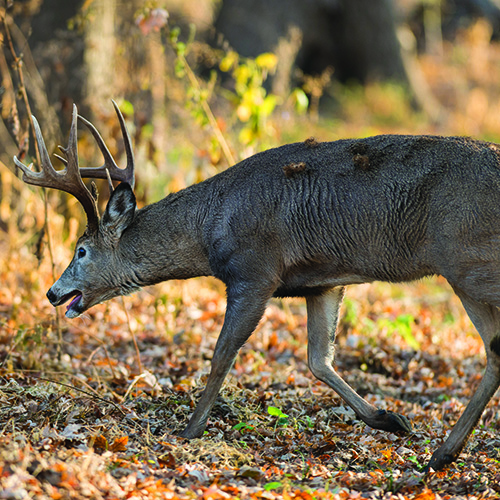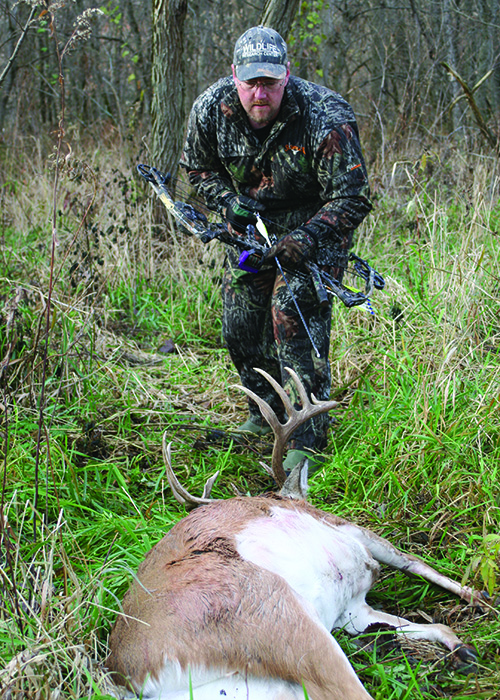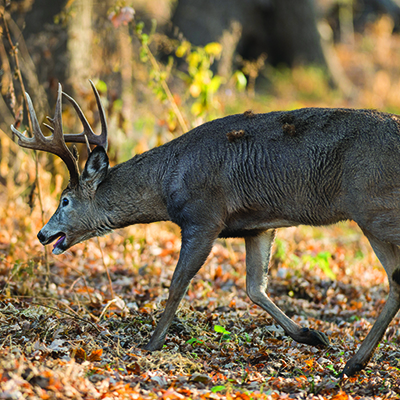D+DH In-Depth is our premium, comprehensive corner on America’s No. 1 game animal. In this graduate-level course, we’ll teach you about deer biology, behavior, and ultimately, how to become a better hunter. Want to be the first to get our premium content? Become a D+DH Insider for FREE!
Stop listening to all the so-called experts. Yes, you can learn enough about a big buck’s rutting behavior to sneak in and outsmart him when his guard is down. Here’s how to do it.
By Steve Bartylla
Opening day of firearms season was only a few days away when I put up this stand. It should have been done sooner, but going in alone and scent-free as if I was hunting, at midday and quiet as I could be, I thought I’d done a pretty non-invasive job.
The stand needed to be up. On my last scouting camera card swap I’d gotten pictures of all three of my hit-list bucks there in the past week. Their times varied, but I was sure I’d tag out opening day — if I got in early and prepared to hang tight for as long as it took.
As I was walking in the next morning a full hour before first light, I began having an argument with myself. Honestly, the arguments with myself are no different than any I may have with my spouse, sibling or friend. The only difference is that they never turn ugly. When the right and left sides of my brain start screaming at each other, then I’ll start getting worried.
What I was arguing with myself over was if I should instead hunt the downwind side of a bedding area. In 100 yards I could either cut left and head there or keep going to where I’d intended. It was a pretty good argument, with solid points on both sides.
Finally, turning left and hunting the downwind side of the bedding area won out. I really couldn’t refute the logic of the left side of my brain. It argued that I knew darn well that the No. 2 buck on the hit list would feed in the crop field, cruise the small kill plot and then check the doe bedding area, venturing in one of several directions from there. He’d been doing just that on most days all rut long. If I hadn’t already filled my bow tag, he’d be caped out already. The left side of my brain promised I’d be done before an hour of light passed, and my right side knew the odds were good that was true.
Sure enough, after less than 30 minutes of shooting light passed, I spotted the buck working his way toward me. It was a head-on shot, so I waited for him to get 30 yards away. When he stopped, I slowly squeezed off the shot. Spinning and running broadside, I emptied the magazine before he crumpled. As so often happens, I throttled him with the first shot and missed most of the rest!
A Pattern Emerges
A lot of thought and effort went into that hunt. I had so much history with that bucks — as is the case with nearly every deer I’ve shot over the past decade or so — that all of those questions that were running through my head were there for good reason. Topping the list was the simple fact that I had spent an enormous amount of time educating myself on this habitat and how these deer use it.
For lack of a better phrase, I let the deer show me how to hunt them. So many of these successful hunts happened during the whitetail breeding season, and almost every one of those bucks was following a rutting pattern when I killed them.
Since I first started hunting as a kid, it’s been crammed down my throat that you just can’t pattern bucks during the rut. I’m sorry for sounding obnoxious, but if they weren’t patterned rutting bucks, then someone better explain to me what patterning a buck means.

Actually, whether we’re talking about heavily hunted public grounds, the typical small property or utopian-like settings, I find that rutting bucks cling to patterns more regularly than nonrutting bucks.
Patterning Defined
Before we can delve deeper into patterning bucks during the rut, we need to agree on what patterning a deer even is. I’m afraid it’s nothing close to what most “experts” pretend. In fact, I happen to know that many bucks they say were “patterned” they had personally never so much as gotten a trail-camera picture of them, seen them, set the stand for them or did anything else related to that buck.
Even when they have done some of these things, I’m afraid exaggeration abounds as to how well they had this deer patterned. Ask any one of these experts, and they’ll tell you they’ve typically tracked these bucks for years, knowing where they bed, feed, drink and travel between all these locations.
Let’s Be Honest
I’m sorry, but I have to call baloney on all of this. One rarely knows all of this. If they do, it will no doubt change as the rut cycles and dynamically changing fall food sources cause bucks to change their patterns often over the course of a season. The only reason most experts pretend they have all of this down is to try to impress you. Then they can sell you on their expertise and their can’t-miss products or services.
In my experience, successfully patterning a white-tailed deer is merely knowing enough about his habits to be able to kill him.
That means you don’t have to know what he does after dark. After all, we can’t hunt him then anyway. Sure, it can be helpful to know what he is doing at first light, but before that often isn’t important.
Next, knowing a travel habit, where he prefers to water, or a food source he somewhat regularly hits during daylight can be enough. The more pieces one can fit together the better. That said, if you know your target passes through a funnel in the last minutes of shooting light en route to hitting the soybean field, does it really matter where he beds?
Get in the Ballpark
In big-woods settings, where food sources can often be a challenge to pinpoint, knowing a buck’s bedding area is often enough. With that, one can typically follow his entrance or exit trail just far enough away to safely hunt it. Where precisely he’s coming from in the morning or going in the evening is really unimportant.
Either way, the key is that you know a tendency. The reality of deer behavior is that patterns are nothing more than tendencies. Between deer activities being tendencies, changing food sources, the comfort factor, the rut cycle and a host of other factors, deer patterns are rarely stable for long.
How Bucks Find Does
Now let’s look at the breeding phase of season. Mature bucks are obviously trying to find estrus does. The myth is that they’re running around at random, hoping to find them by chance. Well that’s pretty much what immature bucks are doing, but Mr. Big is a different animal.
Mr. Big knows his home range. He knows the high-odds locations for finding does during the various portions of the day. He knows where their bedding areas are and realizes that’s where they’re most likely to be for most of the daylight hours. He also knows where they feed and that they’ll likely be heading there in late afternoon or early evening and be in various feeding locations through early morning hours.
In bedding areas with defined edges or concentrated bedding pockets, a quick cruise of the downwind side can typically tell him if any occupant does are ready. If so, his nose leads him right to her. If not, he’s on to the next bedding area.
At food sources I used to believe bucks scent-checked does from a distance far more than they really do. Under very heavy hunting pressure they will often run the downwind side if cover allows. If not, they tend to run the outside checking trails for telltale odors. However, in most average and low hunting pressure settings they most often just enter the source and do a quick visual and olfactory inspection.
Running benches is another common tactic in ridge and bluff country. This kills two birds with one stone. Benches are common locations for does to bed. So at the same time, the bucks can scent-check bedding areas and the trails of every doe that’s fed low and bedded high, crossing the bench to get there.
Another tactic in ridge and bluff country is running on the downhill and downwind side of the top. Doing so allows them to scent-check the top, while also using their eyes to scan ahead and below for any does.
Defining the Pattern
Now let’s put this all together. Mature bucks are most often checking doe bedding areas during the day, as that’s when does are most often there. They also tend to be running just off the ridgetops and benches during the day, checking both bedded does and their trails.
Food sources are good choices in the very early morning and the last hours of daylight, as that’s where the does are. In heavy pressure areas, bucks tend to check open food sources from inside cover, either scent-checking the does that are there feeding, checking their trails or both. In normal to low pressure hunting areas, they most often enter the food source for a swifter check.
If that isn’t a pattern, what is? Sure, a buck fight, breeding or chasing a doe can all temporarily throw these patterns off, but there are countless things during other phases of the season that throw off buck patterns, as well. Unlike during the nonbreeding portion of season, odds are very high that Mr. Big will return to these patterns shortly after his diversion is finished. After all, the doe bedding and feeding areas didn’t change during this diversion and he’s still focused on finding more hot does.
Too Good to Be True?
This all sounds great, but research shows that bucks expand their home ranges during the rut. Sometimes these expansions are considerable, and that throws all this out the window, right?
Actually, this is a prime example of where telemetry studies mislead us. The ability to track bucks with many scouting cameras on large properties has provided me with some insight into this behavior. During the peak breeding season, the majority of these excursions occur when Mr. Big either cuts the track of an estrous or near estrous doe, or is chasing one. This begins where a portion of her home range overlaps his, but she then leads him to the area that doesn’t overlap.
It’s not that he’s left his home range, blindly searching for a doe. It’s that he found one within his normal home range and she led him astray.

The majority of times he returns to his home range when he either loses her or he finishes breeding. Those telemetry studies don’t reveal why he left. It only shows that his home range expanded.
When you really think about it, it only makes sense that he doesn’t want to leave his established home range. He has way more girls than he can handle and knows where they are likely to be at any one time during the day within this area. He has no clue what’s going on outside his home range. Mr. Big can’t ask directions to the hot food sources or doe bedding areas. He leaves the area he knows and he’s truly lost, not to mention that he stands an increased chance of getting in a serious fight with any other mature buck that may spot him.
There are two exceptions to this. One is when he’s led on an excursion by that hot doe. What happens when he’s returning to his range and stumbles across another ready or near ready doe, whose range takes him even farther away? He finishes with her, yet stumbles across yet another, leading him even farther still.
No, that probably doesn’t happen every time. However, one must remember that an awful lot of does are hitting estrus during a fairly condensed period of time. This may not happen most of the times he is led astray by that first doe, but it also isn’t completely improbable. I believe this chain reaction is ultimately what’s most often responsible for a buck suddenly popping up five or 10 miles away from an area he almost never leaves.
One More Stipulation
The other exception I’ve noticed can occur after peek breeding has concluded. Mr. Big realizes there are still breeding opportunities to be had after the majority of adult does have been bred, with a few stragglers and doe fawns still to come. Up until now he’s had plenty of does from his home range to keep him occupied, but he’s going to be hitting some dry patches now.
This is when I tend to see that solo buck in areas he doesn’t belong. All year long I’ve been getting his pictures way over there, but suddenly he’s way over here for no apparent reason, only to show up in a picture in another area a day or two later. I believe it’s because he’s desperate to find those remaining opportunities and he’s now more willing to take a shot in the dark. That’s just one more reason the early post rut can be a great time to tag a great buck. I’ve found it’s actually more likely during that time to pick up never-seen-before roamers than during the peak rut.
Still, both of those situations are more the exceptions than the rules. Most mature bucks I’ve tracked with cameras over the years never do more than a brief excursion and otherwise stick rigidly to their established home range. While there, they have a distinct pattern of checking the high-odds doe locations during high-odds times.
To really nail down these patterns place cameras on prime food sources, bedding areas and funnels separating any combo of either about two weeks before peak breeding starts. Yes, peak breeding hasn’t started yet, but Mr. Big almost always starts early. Swapping memory cards seven to 10 days later should reveal how he will be running his rut pattern, just be very careful that your camera use doesn’t mess things up.
With that intel, as well as factoring dominance within doe groups into the equation, formulate a plan to kill him and make it happen. More often than you may think, it can really be that easy.
Conclusion
I know we’ve been taught differently, but mature rutting bucks certainly do have a pattern. No, not every buck clings to tight rutting patterns, but not every non-rutting buck does either. In fact, outside of those rare bucks whose feeding patterns you can set a clock to, I find that mature rutting bucks tend to be more easily patterned and their timing more regular than at any other time during the season.
For more of Steve Bartylla’s hunting tactics, check out Deer & Deer Hunting’s “Hunt ’em Big!” video series. We house these videos on our website, Facebook Page and YouTube channel. For more information, visit www.deeranddeerhunting.com.
Want to be the first to get our premium content? Become a D+DH Insider for FREE!


